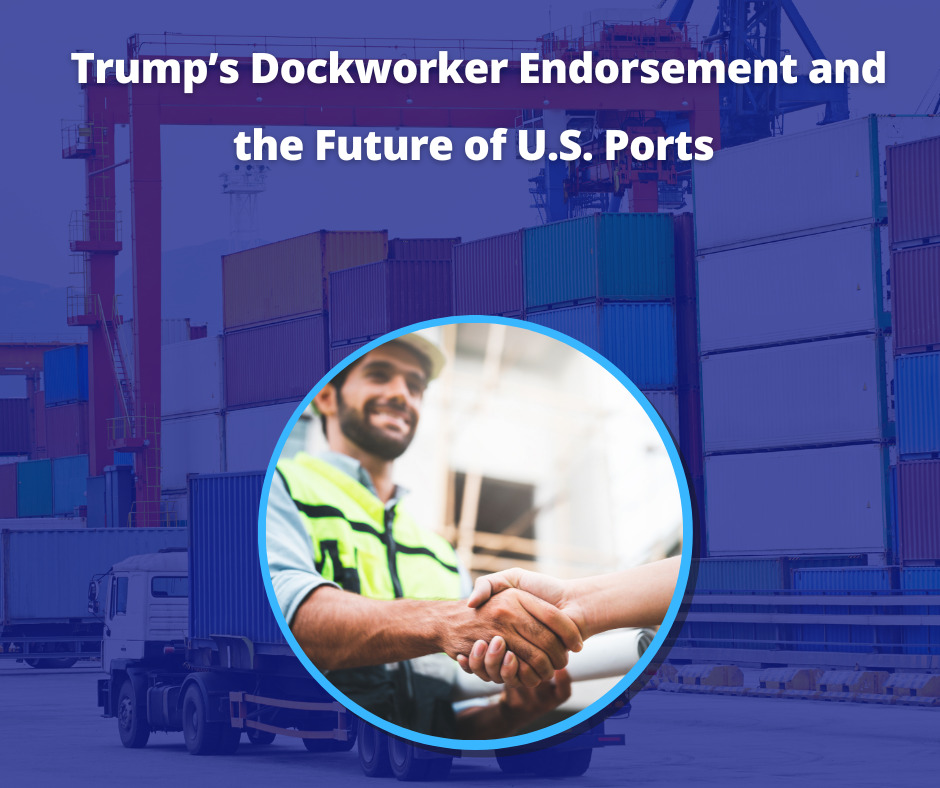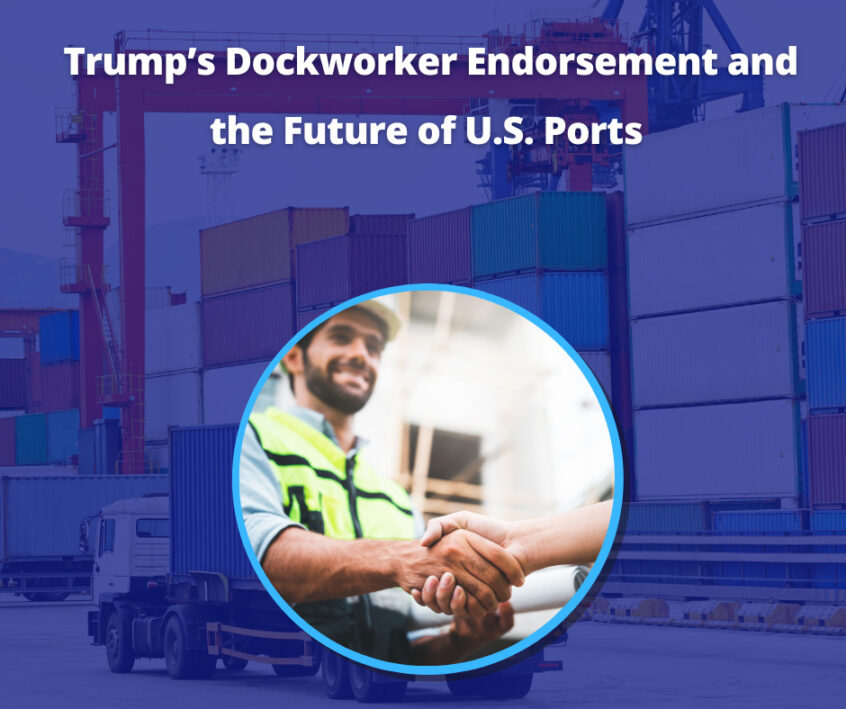
In December 2024, President-elect Donald Trump made headlines by endorsing the International Longshoremen’s Association (ILA) and publicly opposing the automation of U.S. ports. This position, celebrated by labor unions, has sparked widespread debate among economists, policymakers, and industry stakeholders. It represents a pivotal moment in U.S. maritime policy, underscoring the longstanding tension between preserving jobs and embracing the efficiencies that technology offers.
The Historical Role of Labor Unions in U.S. Ports
The International Longshoremen’s Association (ILA), established in 1892, represents over 45,000 dockworkers across the East and Gulf Coasts. Throughout the decades, the union has drawn lessons from its historical experience with containerization and fought to protect its members from technological innovations that could lead to job losses.
The Legacy of Containerization
The introduction of containerized shipping in the 1960s revolutionized global trade by standardizing cargo handling. This innovation drastically reduced shipping times and costs, enabling goods to move seamlessly across continents. However, for dockworkers, it marked the end of an era. Containerization displaced thousands of workers who relied on traditional cargo-handling methods. For instance, the Port of New York lost 70% of its workforce between 1960 and 1980—a trend mirrored in ports nationwide.
This historical context explains the ILA’s resistance to automation. The memory of widespread layoffs looms large in the collective consciousness of dockworkers. Today, the union’s negotiations reflect a continued commitment to safeguarding jobs, as seen in its 2024 agreement securing a 62% wage increase and strict limitations on automation.
Recent Labor Wins
Beyond wages, the ILA has negotiated robust health and pension benefits for its members. These victories underscore the union’s capacity to influence policy and secure political support. Trump’s endorsement is a testament to this influence and signals a broader alignment with populist labor policies.
Automation in Global Ports: A Study in Contrasts
While U.S. ports remain mired in debates over automation, ports around the world are leveraging technology to transform their operations. Automation has become the cornerstone of modern port management, enhancing efficiency, reducing costs, and minimizing human error.
Global Success Stories
- Rotterdam, Netherlands: Home to the Maasvlakte II terminal, Rotterdam’s port is a paragon of efficiency. Automated cranes, guided vehicles, and AI-driven scheduling systems work in tandem to reduce container handling times by 30%, making it a preferred hub for international shipping.
- Singapore: Consistently ranked among the world’s top ports, Singapore has embraced predictive analytics and artificial intelligence. In 2023, it processed over 37 million TEUs with minimal delays, demonstrating how automation can enhance capacity without compromising reliability.
- Shanghai, China: As the busiest port globally, Shanghai handles 47 million TEUs annually. Its automated berths, rail systems, and cargo tracking technologies enable seamless operations, underscoring the strategic advantages of embracing innovation.
These examples highlight the transformative potential of automation but also expose the challenges associated with workforce displacement, as seen in Germany, where protests erupted in Hamburg over job losses linked to port automation.
Challenges Facing U.S. Ports
Trump’s anti-automation stance, while appealing to workers, presents significant operational, economic, and strategic challenges. Without modernization, U.S. ports risk falling further behind their global counterparts.
- Operational Inefficiencies: Reliance on manual labor limits throughput capacity. For example, the Port of Savannah, which handles approximately 5 million TEUs annually, struggles to match the efficiency of its automated peers. Inefficient operations lead to longer cargo handling times, vessel queues, and higher demurrage fees. Furthermore, manual processes elevate safety risks; in 2022, the Bureau of Labor Statistics reported over 7,000 injuries among dockworkers—many of which could have been prevented with automation.
- Economic Pressures: Higher operational costs are inevitably passed on to consumers, increasing the price of goods. Meanwhile, U.S. ports face growing competition from neighbors like Canada and Mexico. The Port of Vancouver, with its advanced automation systems, offers faster turnaround times, attracting shipping lines that might otherwise use American ports.
- Strategic Vulnerabilities: By opposing automation, the U.S. risks losing its competitive edge in global trade. Inefficient ports deter foreign investment and reduce the country’s attractiveness as a trading partner. Additionally, younger generations may shy away from maritime careers, viewing the industry as outdated and stagnant.
Strategic Recommendations for Stakeholders
To address these challenges, the shipping and logistics sectors must adopt forward-looking strategies that balance innovation with job preservation:
- Diversify Supply Chains: Companies should consider alternative routes and inland ports to reduce reliance on coastal terminals. For instance, Walmart has leveraged inland hubs, such as those in Kansas City, to streamline logistics and minimize congestion at coastal ports.
- Invest in Advanced Technologies: Tools like the Internet of Things (IoT) and blockchain can revolutionize supply chain management. For example, Maersk’s integration of IoT devices has enabled real-time container tracking, improving operational transparency and customer satisfaction.
- Foster Collaboration with Labor Unions: Building partnerships with unions is critical to ensuring smooth transitions to automation. Programs that train workers for new roles in managing automated systems can alleviate resistance while preserving productivity.
- Advocate for Balanced Policies: Engaging policymakers to craft regulations that balance technological innovation with workforce protection is essential. Public-private partnerships can fund infrastructure upgrades, ensuring that modernization efforts benefit all stakeholders.
Policy Analysis: Navigating the Intersection of Progress and Equity
Trump’s policy stance reflects broader societal tensions between economic modernization and social equity. While it seeks to protect jobs, it also raises critical economic and political questions:
- Economic Implications: Higher costs at U.S. ports could exacerbate inflationary pressures, raising prices for consumers and straining household budgets.
- Political Considerations: Trump’s alignment with the ILA strengthens his appeal among unionized workers in key swing states. However, it risks alienating business leaders and investors who advocate for modernization.
Balancing Tradition and Transformation
The debate over automation in U.S. ports encapsulates a broader challenge facing modern societies: balancing the preservation of traditional labor practices with the need for technological progress. Trump’s endorsement of the ILA highlights the complexities of this issue and underscores the need for inclusive policymaking that addresses both economic and social dimensions.
For the shipping and logistics industries, the path forward lies in embracing innovation while fostering collaboration with labor and government stakeholders. By adopting proactive strategies and leveraging global best practices, U.S. ports can maintain their relevance in an increasingly competitive landscape. The future of American ports depends on finding common ground between tradition and transformation, ensuring their continued role as vital nodes in the global supply chain while advancing equity.


